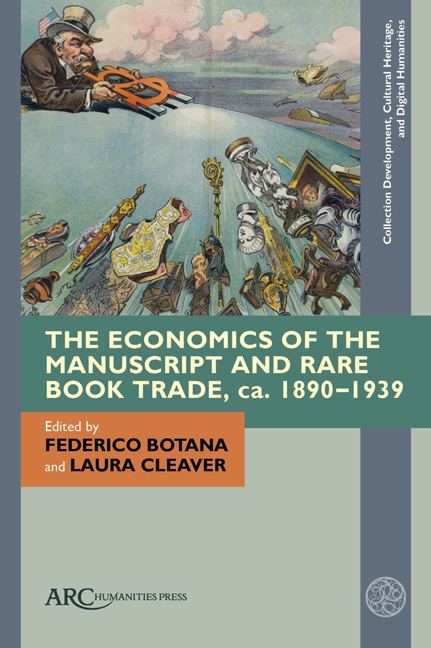Book contents
- Frontmatter
- Contents
- List of Illustrations
- List of Tables
- Acknowledgments
- Abbreviations
- Introduction. The Value of Rare Books
- Chapter 1 Valuing Rare Books in 1920s Germany: Prices in Jacques Rosenthal’s Bibliotheca medii aevi manuscripta
- Chapter 2 Leo S. Olschki’s Card Index and Potential Profits
- Chapter 3 Stock-books and Ledgers: J. & J. Leighton and Édouard Rahir and Company ca. 1897–1904 and E. P. Goldschmidt and Company ca. 1925–1933
- Chapter 4 Léopold Delisle, Henri Omont, and the Price of National Collecting: The Medieval Manuscript Acquisitions of the Bibliothèque nationale ca. 1900–1910
- Chapter 5 Herschel V. Jones: Public Collections and Private Investments
- Conclusion
- Appendix 1 Inflation
- Appendix 2 Exchange Rates
Conclusion
Published online by Cambridge University Press: 28 March 2024
- Frontmatter
- Contents
- List of Illustrations
- List of Tables
- Acknowledgments
- Abbreviations
- Introduction. The Value of Rare Books
- Chapter 1 Valuing Rare Books in 1920s Germany: Prices in Jacques Rosenthal’s Bibliotheca medii aevi manuscripta
- Chapter 2 Leo S. Olschki’s Card Index and Potential Profits
- Chapter 3 Stock-books and Ledgers: J. & J. Leighton and Édouard Rahir and Company ca. 1897–1904 and E. P. Goldschmidt and Company ca. 1925–1933
- Chapter 4 Léopold Delisle, Henri Omont, and the Price of National Collecting: The Medieval Manuscript Acquisitions of the Bibliothèque nationale ca. 1900–1910
- Chapter 5 Herschel V. Jones: Public Collections and Private Investments
- Conclusion
- Appendix 1 Inflation
- Appendix 2 Exchange Rates
Summary
THE CASE STUDIES collected here examine a variety of sources, focusing on different periods and covering a range of manuscripts and rare books; yet common themes emerge. The recurrence of the names of buyers and sellers in the different case studies underlines the extent to which prices were determined in the context of a relatively small network of people. In addition, the large volume of publicly declared prices, at auctions, in catalogues, and in newspapers, meant that it was possible for participants in the trade to be extremely well-informed. Dealers’ and collectors’ private records also allowed them to keep track of their own activity and provided points of comparison for future sales and purchases. Manuals provided guidance on how an individual book might be appraised, offering insights into contemporary values, but relationships between buyers and sellers could also influence prices.
It is an obvious point, but successful dealers sold books for profit. Most firms achieved this through a combination of acting on commission for collectors, offering books to clients (in a shop or by letter), and advertising through catalogues. J. & J. Leighton’s records demonstrate that the firm sold much of its stock within days or weeks, meaning that many books never appeared in a catalogue. Manuscripts that were included in catalogues, such as those by Jacques Rosenthal and Leo Olschki, were therefore slower to find a buyer, prompting consideration by the dealer about how to describe and price them and who to offer them to. Within this general model, firms operated in slightly different ways, apparently linked to the spending of their clients. Olschki’s average markup in 1910 was substantially higher than Leighton’s and Rahir’s in ca. 1905 and his success seems to have been linked to his ability to sell manuscripts to wealthy American clients for large profits. Yet to serve their different clients dealers traded with one another as well as buying books at auction. A book bought from Leighton by Olschki with a client in mind could therefore yield profits to both dealers.
From library and dealers’ records we can track books through different hands over time with great precision. Remarkably, some manuscripts reappear even in this set of case studies. As Hannah Morcos demonstrated, a manuscript bought at Sotheby’s by Leighton in 1901 was sold to Olschki, who sold it on to the Bibliothèque nationale.
- Type
- Chapter
- Information
- The Economics of the Manuscript and Rare Book Trade, c.1890-1939 , pp. 115 - 118Publisher: Amsterdam University PressPrint publication year: 2024

